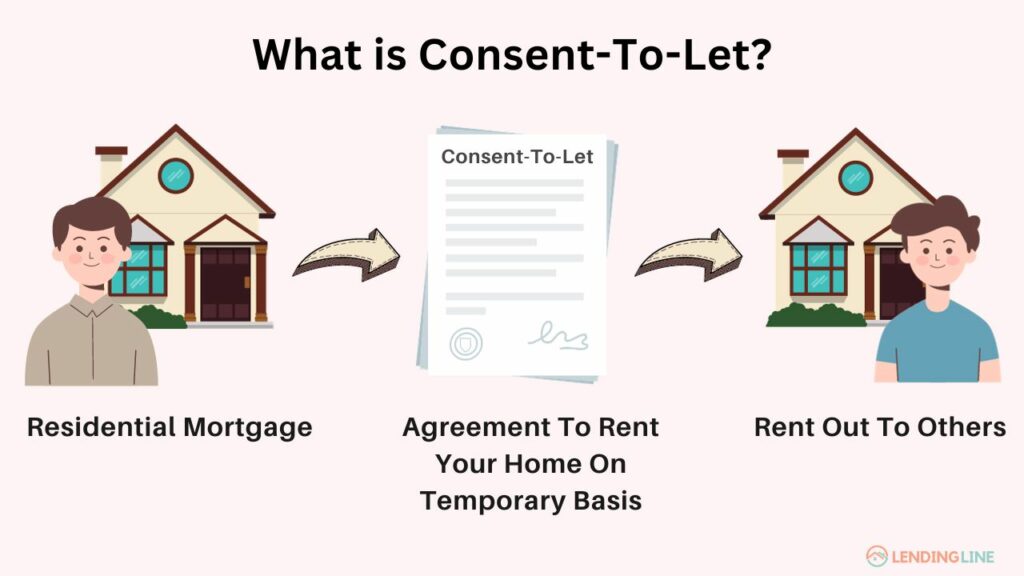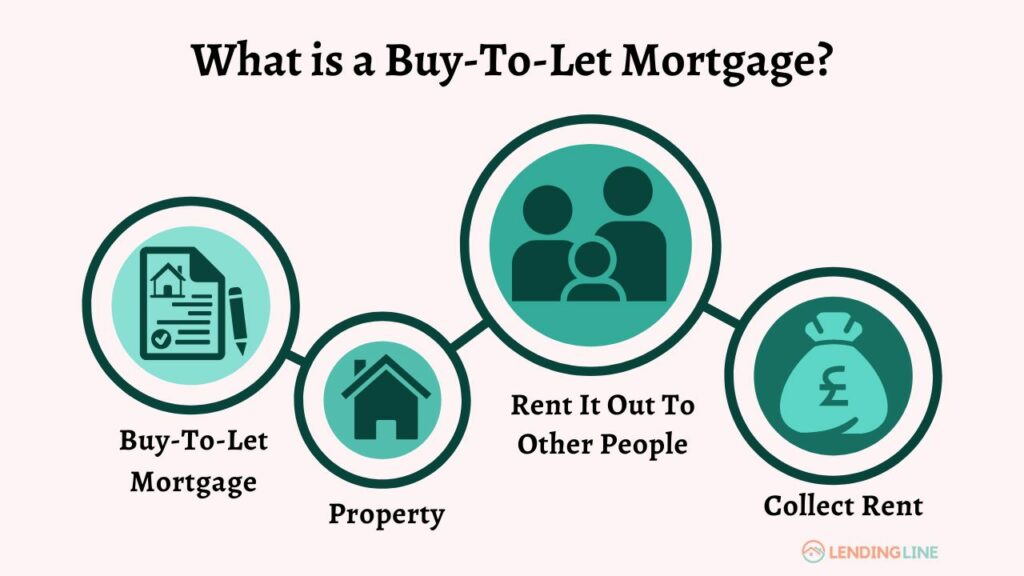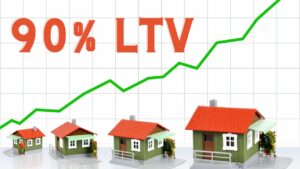Sometimes people possessing a residential mortgage on their home may prefer to use their current property as a buy to let investment, whilst making onward arrangements in terms of a new place to live.
An option some consumers consider is changing mortgage to buy to let mortgage by taking consent from the current lender or opting for remortgage plans.
It’s a great way to hold onto the property to enjoy the monthly rental income. So, if you want to know about changing your mortgage to buy-to-let, read this guide for all the details.

Table of Contents
- Factors To Consider Before Changing Mortgage To Buy To Let?
- How To Change Mortgage To Buy-To-Let?
- Which Option Is Better – Consent-To-Let Or Remortgaging?
- How Will The Mortgage Calculations Change?
- Is Switching To A Buy To Let Mortgage Easy?
- Can You Avoid Changing Mortgage To Buy To Let Mortgage?
- Why Are Buy-To-Let Mortgages more Expensive?
- How Quickly Can You Remortgage To A Buy-To-Let
- Will You Have To Pay Stamp Duty On A Buy-To-Let Mortgage?
- How Can You Secure A Buy-To-Let Mortgage?
- Conclusion
Factors To Consider Before Changing Mortgage To Buy To Let?
Switching mortgages and opting for a buy-to-let option isn’t as easy as choosing your favourite flavour of ice cream.
You can’t decide on a whim, as a wrong decision will have serious consequences on your finances and family.
Most importantly, there’s no guarantee you will qualify for a buy-to-let mortgage, so let’s look at certain factors you must keep in mind –
- What are your intentions with the property?
- What is your current mortgage type?
- Do you have other mortgages?
- Have you made future living arrangements?
- Do you have consent from the lender?
- On what terms have you taken the current mortgage?
How To Change Mortgage To Buy-To-Let?
If you have the answer to the above questions, you will now have a question of your own – how to change to a buy-to-let mortgage?
The short answer is that people with a residential mortgage, who want to let out the property, could consider the following options.
A. Taking Consent From The Lender
Your current residential mortgage lender may grant you ‘consent to let’.
This is where the mortgage remains a residential mortgage, but the residential lender will allow you to let the property for a certain period before they would expect you to re-mortgage to a buy-to-mortgage if you do not intend to move back into the property.
The lender will often charge a small fee and add a certain percentage onto the current mortgage rate because they are allowing you to do this.
If you are taking out a new residential mortgage and you think you may need consent to let at some point, it is often a good idea to check whether the lender for the new mortgage you are taking out typically allows this during the mortgage contract at outset.
B. Remortgaging Buy-To-Let Mortgages
There are times when a current lender might not agree to letting out the property, in which case you can remortgage to a buy-to-let mortgage.
Some of the grounds on which a lender can deny consent include:
- History of mortgage arrears
- Long-term plan for letting out the property
- Unhappy with the intention of changing mortgages
If you remortgage the property, it means striking a new deal with another lender. The new mortgage will now be a buy to let mortgage and thus the property is assessed primarily for its rental income.
Which Option Is Better – Consent-To-Let Or Remortgaging?

Both options have merits, but getting consent from your lender offers unique advantages.
With consent to let the lender will typically charge an admin fee and might change the rate of interest for the period of the tenancy.
This is because some lenders suspect people deliberately opt for a residential mortgage rather than a buy-to-let mortgage to secure a better deal before changing it later.
Moreover, when you have consent, you can move back into the property in the future, as most lenders provide permission to let for 6-12 months.
If you’re lucky, some lenders will keep the original terms and conditions the same or may extend the let period.
How Will The Mortgage Calculations Change?
You can consult a mortgage broker to determine the new buy to let mortgage product that you could potentially switch to.
Factors to consider are the equity in the property, rental value of the property, new interest rate, new mortgage arrangement fees, and terms of the new buy to let mortgage.
Lenders calculate the rental income typically using interest coverage ratio (ICR) to determine how much you can borrow against the property.
In most cases, lenders expect the rental income to be a minimum of 125% of the monthly interest mortgage payment, while the LTV is usually a maximum limit of 75%.
You will also have to inform the lender how much you want to borrow for the new property to meet all the necessary criteria.
Is Switching To A Buy To Let Mortgage Easy?

When you want to make changes to the mortgage type, the best option would be to speak to a broker. The experts will advise you on how to proceed with letting out a house that you have at the moment.
If you consider the options we have discussed so far and factor in costs and equity, it’s not challenging to change to a buy-to-let mortgage. That said, people who have possessed the property for a while are more likely to get the change sanctioned.
This is because such people may have reduced the overall mortgage balance thus far through regular repayments so will have more equity in the property.
The bigger problem is for people who have just possessed the property and don’t have sufficient equity. Since most lenders will provide a maximum loan of 75% of the value of a property,
Can You Avoid Changing Mortgage To Buy To Let Mortgage?
Once you gain consent from the lender, you are likely overpaying on the mortgage with the added interest rate being applied.
You might have noticed that buy-to-let mortgages usually operate on an interest-only basis with the principal debt being repaid at the end of the loan.
The usual repayment plan is to sell the property at the end of the term whilst the property generates rental income to cover the mortgage payment.
There are a couple of things to consider at this point. If you want to repay the outstanding amount on the property instead of capitalising on rental income, stick to capital repayment.
Although it may seem difficult initially due to the higher costs, you can enjoy the monthly rental income when the mortgage is paid off with no debt outstanding.
Just remember it could cause problems if there are any complications with receiving rent and you can’t manage the higher monthly mortgage repayment.
So, please bear this in mind when choosing a repayment plan of interest only or capital repayment.
Why Are Buy-To-Let Mortgages more Expensive?
Buy-to-let mortgages are typically more expensive since the risk for lenders is considered higher. There could be rental voids and potential complications with tenants.
How Quickly Can You Remortgage To A Buy-To-Let
It’s possible to remortgage to a buy-to-let from the first day itself, with lenders willing to accept this proposal if the scenario makes sense. But we have seen more options open up for people willing to wait for at least 6 months.
It would be best to discuss any buy to let remortgage with with an experienced mortgage broker since remortgaging often has several financial consequences.
For example, residential customers agree to a mortgage at a fixed rate, which means if they remortgage the property and choose a new lender, they are required to pay an early repayment charge if they re mortgage within the fixed rate period.
Early repayment charges are what push many consumers to choose consent-to-let mortgages. When you have a reliable broker, they will explain all the intricacies of the process.
Will You Have To Pay Stamp Duty On A Buy-To-Let Mortgage?
When you re mortgage a property and change the mortgage type from residential to buy-to-let, no stamp duty usually occurs.
It only does if you buy another property and in this instance you will more than likely have to pay a surcharge .
Most importantly, the date of buying the property and the date when you changed it to a buy-to-let mortgage are important. You should consult an expert in property taxes to deal with Capital Gains Tax in such situations.
Note that all investment properties are usually subjected to taxes when you sell the house. Stamp duty centres more around acquired properties.
How Can You Secure A Buy-To-Let Mortgage?
Whether you get the buy-to-let mortgage depends on the criteria set by lenders. While the terms and conditions vary from one lender to the next, we have shortlisted 3 important factors.
1. Where Do You Plan To Stay?
Most lenders are unwilling to let you switch mortgages if you want to rent the property and shift into rented accommodation.
This is a red flag for most lenders since buy-to-let mortgages are only sanctioned mostly for people with a minimum of one residential mortgage in a lot of cases. This eliminates the risk of you moving back into the property.
2. Duration
People who haven’t had a residential mortgage for 6 months will find it tough to switch mortgages more commonly.
3. Experience
Consumers who have previously rented properties and have more experience as a landlord might get competitive rates and favourable deals from lenders than others.
Conclusion
Switching your residential property to a buy-to-let mortgage could offer a current residential homeowner a myriad of benefits.
Some lenders will be willing to allow ‘consent to let’ however in some instances you may need to re mortgage and move onto a new buy to let mortgage product for the property if the current residential mortgage lender does not allow this.
Moreover, it’s essential to have sufficient equity and make sure to generate significant rental income to cover all costs.
**A buy to let mortgage will be secured against your property.
Some types of buy to let mortgages are not regulated by the Financial Conduct Authority.
All content is written by qualified mortgage advisors to provide current, reliable and accurate mortgage information. The information on this website is not specific for each individual reader and therefore does not constitute financial advice.
I am CeMAP & CERER qualified mortgage adviser and have helped a number of clients realise their dreams when they thought it would not be possible. I’m skilled at getting mortgages sorted for people with a history of missed payments, CCJs, defaults, debt management programmes, IVAs and bankruptcies.
I am CeMAP (Certificate in Mortgage Advice and Practice) qualified mortgage adviser with a strong background in Finance. I specialise in providing expert advice on a range of mortgage products, including first-time buyers, remortgages, buy-to-let mortgages and bad credit mortgages.









